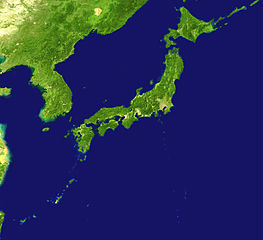Before moving to another country, a bit of fact finding is in order. As I like numbers, here are some statistics:

Japan (日本) – Nihon or Nippon in Japanese – is an archipelago consisting of 6852 islands located between 20° – 43° N and 122° – 153 ° E, comprising a total area of 377.915 sqare km. The four main islands are (from North to South) Hokkaido, Honshu, Shikoku, and Kyushu. The climate is mostly temperate, but obviously there is large variation between the humid continental of the North and the subtropical of the southern islands. The temperatures average between 5.1 °C (winter) and 25.2 °C (summer), the highest ever recorded lay at 40.7 °C. Japan has a rainy season from May (South) to July (North), and there are numerous typhoons in the autumn.
Japan has more than 127.000.000 inhabitants, which makes it the 10th most populated country in the world. About 13.000.000 Japanese live in the capital city Tokyo (東京), and counting the larger Tokyo Metropolitan Area, it’s more than 35.000.000, giving the area a densitiy of about 2600 people per square km. However, this is going to change, as the population growth is negative at -0.077%, with a birth rate of only 8.39 per 1000 population (217th in the world), and a death rate of 9.15 per 1000.
The country has been inhabited since the paleolithic, about 30.000 BCE. The feudal era is problably the best known outside of Japan, starting with the emergence of the samurai class about 1200 CE, and ending with the Meiji restoration in 1868. Today, Japan is technically a constitutional monarchy, but the emperor (currently: Akihito) has very little actual power.
Both China and Korea have had a great influence on Japan’s culture, but many of those cultural imports have received a quite specific Japanese twist – just think of Zen Buddhism. Once again, the feudal era gave rise to many of the pastimes and arts so admired abroad, like the tea ceremony, ikebana, and martial arts; but also wooden dolls, painted kimonos, and the whole entertainment culture of the Geisha.
Japan is the third largest economy in the world, and hence, one of the G8 states; and that despite the fact that it has very little natural resources and is the 4th largest importer of crude oil. Most of its electricity (63%) is generated using fossil fuels, and also nuclear power goes strong here (17%). The gross domestic product per capita is 34,700 US$, currently shrinking at -0.8%.
Its work force comprises about 66.000.000 people, the majority of 70% working in the services sector, and only 3.8% in agriculture – that’s even less than the unemployment rate of 4.6%. Anyway, industries abound in Japan, especially for highly advanced products like cars and electronics, but also chemical substances and processed foods. Clearly this goes along with (fundamental) scientific research – there are about 700.000 researchers with a total budget of 130 billion US$, the third largest in the world.
There are 1.200.000 km of paved road in Japan, but still, driving makes up for only about 50% of the distance traveled. Another major means of transport is the railway, with 27.182 kilometers of rail in total, and 250 shinkansen bullet trains connecting the major cities. There are several regional companies all over Japan and dozens of small railway companies around the major cities. Only 9 cities have a metro system, but there are buses available everywhere. There are 173 airports in Japan, with the second busiest in all Asia being Tokyo-Haneda, and the largest Tokyo-Narita. Finally, lots of ferries connect the islands – especially the smaller ones – on 1770 kilometers of waterways, with the largest port in Nagoya.
